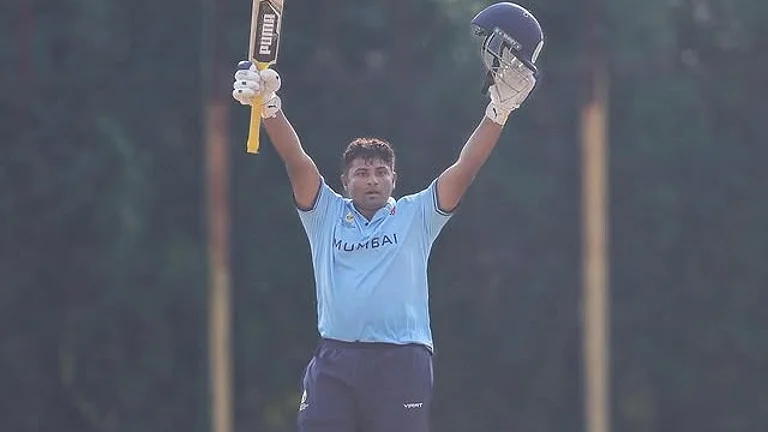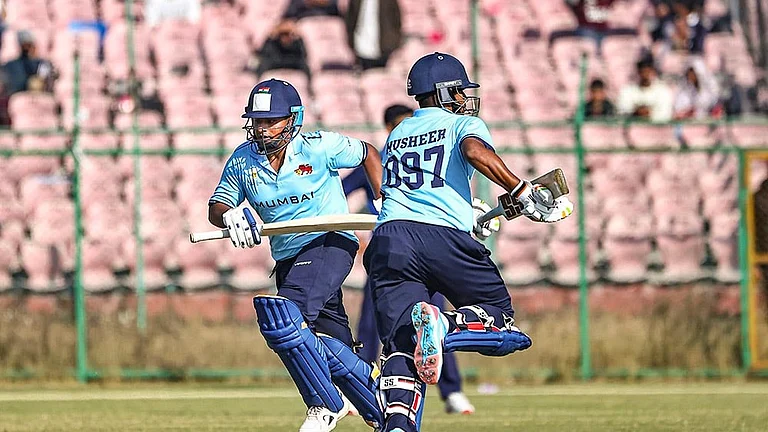22 Yards To Glory
- He has captured 14 wickets in four matches till the Bangladesh tie in this World Cup
- He is the second bowler after Shahid Afridi to take three 4-wicket hauls in successive World Cup matches
- He’s second Indian to bag a World Cup hat-trick, against Afghanistan, after Chetan Sharma did the same against New Zealand in 1987
- He’s only the second Indian after Narendra Hirwani (1988) to claim three 4-wicket hauls in successive ODIs
***
Before in-form pacer Mohammed Shami embarked on the successful tour of Australia-New Zealand this January-February, he levelled the large mud field of his farm house in Amroha, marked a running track that also has provision for 50m and 100m sprints. This was part of his renewed, intense focus on fitness. The outcome is that Shami is being seen in a new avatar, having recovered from several injuries and overcome personal problems.
The result of his new fitness regimen and simultaneous polishing of his bowling under the watchful eyes of his childhood coach, Badrruddin Siddiqui, in nearby Moradabad was seen during the four ODIs against New Zealand. He bagged nine wickets at a miserly average of 15.33, a performance that fetched him the man-of-the-series award. A little earlier, he had excelled in the four-Test series in Australia, where he captured 16 wickets at an impressive average of 26.19.
So, when Shami returned home from Down Under, his confidence had gone up several notches, he was highly motivated, and was charged up. He again hit the mud track, along with handpicked trainees of Siddiqui, to get ready for the home ODI series against Australia. Although he proved expensive in the four matches, the diminutive pacer was an automatic starter in the selectors’ World Cup XV that they were yet to pick. But for India’s initial World Cup matches, Bhuvaneshwar Kumar was instead picked in the XI, while world No.1 Jasprit Bumrah was the other obvious choice. Then, Kumar got injured and Shami grabbed the opportunity with both hands. He snared three successive four-wicket hauls, including a hat-trick against Afghanistan. Till the Bangladesh game, he has 14 wickets in four matches.
“Shami is in the best bowling form of his career, so far. He has the best wrist position in the world. His seam position is great; when he bowls you can see only the vertical seam, something that I had. Moreover, he is bowling from very close to the stumps, and when one does that, batsmen can’t make out whether it will be an in-swing or an out-swing (delivery). He also has a very effective bouncer,” Manoj Prabhakar, a master of swing and the slower delivery, tells Outlook.
Prabhakar even compared Shami with legendary Aussie Glenn McGrath in certain aspects. “McGrath was a brilliant out-swing bowler, but his incoming delivery was unplayable and that’s why he was a world-class bowler. Now, Shami has everything in his bowling arsenal. What I learnt in eight-nine years—because there was none to teach me—Shami has learnt [the advantage of bowling close to the stumps] in just four years. He is class; he can be a match-winner any day,” said the former India all-rounder.
Chetan Sharma, the first and the only other India pacer to take a hat-trick in the World Cup, credits Shami’s fitness for his great turnaround. “All this change has come about because of his improved fitness. When you are fit, you are confident, get the rhythm, and the speed, too, comes automatically. If you’ve even a niggle, it prevents you from giving your 100 per cent,” says Sharma, who bagged the hat-trick against New Zealand during the 1987 World Cup.
Sharma says in his about 35-year association with cricket, he has hardly seen a bowler with such a flexible wrist and a perfectly straight seam position. “Only one or two, maximum three, bowlers are born in a generation who have a wonderful seam position, which is better than Bhuvneshwar’s. His ball doesn’t wobble. He’s far ahead of others, with the new ball or the old one. His yorker has become potent,” he gushes.
Siddiqui reveals how Shami transformed himself. “After he failed the yo-yo test in June last year and was dropped for the one-off Test against Afghanistan, he sought a trainer’s guidance and worked hard on his fitness at his farmhouse in Sahaspur Ali Nagar, Amroha... He would do the running and visit my academy for bowling practice in the evenings. Today, he looks fitter than in 2013 when he made his international debut,” Siddiqui says.
“His wrist position has always been good. But, at times, he used to err in line and length. Now, he has much more control over the ball. Also, he didn’t have a slower delivery. Now, he has added that too to his repertoire. Playing in IPL has also helped him develop as a complete bowler as the T20 format requires clever bowling,” points out Siddiqui.
Haseeb, elder brother of Shami, says it was a “desi” innovation. “It was not just a simple mud track. We watered the track so that the soil becomes sticky, making it difficult to run fast. That helped Shami improve his fitness; he worked hard at it. He used the 100m track to practice for the yo-yo test. Also, he is mentally strong, naturally, that’s why he overcame a few hurdles in the last year-and-a-half,” informs Haseeb.
Besides getting fitter, Shami also overcame family issues last year to emerge mentally stronger. The BCCI’s anti-corruption unit also investigated an allegation of match-fixing against him before giving him the clean chit. Sharma relates to Shami’s personal problems. “When such things happen, I know they shake you up as I’ve experienced that. When Javed Miandad hit me for a title-winning six in the Austral-Asia Cup final in 1986, the whole country was cursing me, and my parents and my coach, late Desh Prem Azad, had to protect me from going out and avoid people who might talk about that six,” he recalls.
Shami has since cleared all the hurdles, and is now making the ball talk, swing, and bounce. “If the captain uses him as an asset, he will be a bowler for the long run. Now he will take more wickets in Test cricket. I’m saying this because the red ball in Tests swings for about 30 overs while the white ball swings for just five overs or so. And with his wrist position and action, he will be a terror with the old ball in Tests, provided he learns to hide the ball [seam from batsmen while running in],” predicts Prabhakar.
The versatile Shami is an automatic choice for the national team in Test and ODI cricket. After his World Cup performance so far, he would surely have staked fresh claim for a spot in the T20 team as well. In the meanwhile, there are changes afoot at Shami’s farmhouse, with the blueprint containing a few new structures, including a modern swimming pool.
A fitter, leaner and meaner Shami is bad news for batsmen across the world: Watch out for that yorker delivered in searing pace!


























